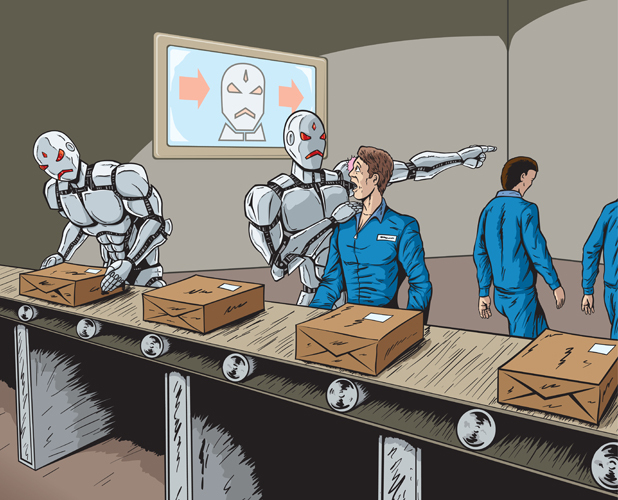Reference related infographic.
Historically, technology has always created new jobs by automating repetitive and mundane work with predictable, expected results. This has led to the creation of new job types that are more evolved yet challenging. For example, delivery by drones may replace human delivery jobs, but this automation opens up a number of new specialized jobs that require higher expertise, such as GIS experts, geospatial data analyst/scientist, algorithm designer/developers, control center operators, and security experts.
Another angle to consider is that automation will give us more free time to undertake hobbies or creative and innovative pursuits. However, looking at 140 years of data shows that automation has always created more work.

But hundreds of delivery personnel can’t all learn these skills, yet they will lose their jobs unless they evolve. Change is hard, especially for the unprepared; but we need to learn from experience. We have come a long way from postcards to emails.
We often come across cases of individuals, like a manual tester, who has spent the last 10 years of their career doing manual testing. But now he is unable to learn automated testing, and as a result he is losing his job. Evolve or perish, that’s the mantra!
Not all jobs will have a clear evolution path, like the typists who evolved by learning word processing as typewriters were being replaced by personal computers. We can conclude that automation will impact low-skilled jobs and create new jobs that use human intelligence and creativity. Upskilling is the way forward for those affected.
Here are 7 areas where we see automation both eliminating and creating jobs:
1) Jobs that have been made obsolete by automation
Automation has made a significant impact on jobs in the manufacturing industry. Robots have replaced workers and increased productivity. And we already see automation all around us: ATMs replaced bank tellers, point-of-sale machines replaced checkout clerks at the supermarket, and automated ticket kiosks replaced ticket agents at airports. The list goes on with telephone operators, travel agents, timekeepers, typists, film projectionists, packing labor, stockroom and warehouse personnel, farmers, data entry operators, call center operators, weavers, and knitters.
2) Jobs that are not yet obsolete but are at risk
Research indicates that by 2021, four out of ten jobs will be lost to automation. Jobs that are at risk are ones that are highly transactional and can be automated using Artificial Intelligence and Machine Learning (AI and ML).
Examples include delivery personnel who are losing their jobs to drones. and Taxi and truck drivers will follow suit if Daimler, Tesla, and Google succeed in their plans to make driverless vehicles. The list of jobs at risk continues with nurses, insurance underwriters, geographers, nuclear technicians, financial advisors, news reporters, loan officers, accountants and auditors. Many of these jobs will have their next version and a different set of objectives and key results to serve much more evolved customer demands and business models. About 40% of these at-risk jobs will go away in the next 5 to 10 years and we can’t say for sure if your job is one of those. So it’s safer to assume that all of these jobs will become obsolete in the next 10 years.
3) New IT jobs are created by automation
Technology is evolving faster than ever. IBM Watson, Google’s Deep Neural Network (Tensorflow) and several other AI and ML platforms require humans with a specific skillset to implement various business models and use cases on those platforms. A new breed of systems integrators, called Robotic Process Automation (RPA) implementers, are building systems with optimized workflow. Skills like DevOps are in high demand due to the need to further automate the service offerings via continuous integration and continuous delivery (CI and CD). CD results in effective use of infrastructure resources by reducing the time to market for new products or services in addition to improving the efficiency and reducing the cost. Another in-demand skill is the ability to convert old monolith applications to containerized microservices. Containerized microservices with container orchestration are taking the discipline of DevOps to the next level.
4) Industry verticals most likely to be impacted by automation
Businesses today are striving to enhance their customer experience. They are building products and services that will help customers to achieve the same results, just more quickly and effectively. At the same time businesses – both B2C and B2B – are collecting lot of data about behavior, productivity and performance issues. One example is automated car refueling and servicing, where your car goes to refuel itself from the nearest gas station while you are at work or spending time with family. The data is sent to the service station 24/7, so it already has the data about all the vitals of your car along with exact issues.When the car goes in, the servicing is done by a fully automated service robot and you’ve saved yourself that extra worry about your car It may sound farfetched, but this reality is closer than we believe.
To handle all of this data, almost all industries will need to leverage the power of AI and ML. Healthcare, agriculture, manufacturing, transportation, customer service, finance and defense are going to be benefit from these technologies. And asa result, new jobs will come into existence and will need new skills. The speed of the skills treadmill is increasing continuously and so is the pace of change. For example, just a few years ago, DevOps skills were in demand. But today, developers are writing containerised microservices and they can both build and deploy without any help from DevOps. This way of working called NoOps has made DevOps skills redundant.
5) Opportunities for IT Professionals in Non-IT Sectors
IT departments in non-IT organizations will benefit from the advances in technology and automation. Presently, most companies have a technology departmen;t however updates to the latest technology are a constant challenge in terms of cost, and there are new skills required. As a result, technology, and the IT professionals who manage it, are becoming central to the future strategies of these companies.
The smart systems mentioned in #4, we will require skilled IT professionals who are not only capable of developing solutions based on intelligent platforms, but are also quick learners. As non-IT sectors start being heavily driven by IT, more technologists will be needed to maintain existing systems, cater to new business cases, and alter existing solutions — all while ensuring data security. Governmental rules and regulations will need to evolve based on learnings from automation initiatives such as driverless vehicles. This, in turn, will open new careers for IT professionals in the law enforcement field.
Right now, every company is a software company. Ford sells computers-on-wheels. McKinsey offers consulting-in-a-box. FedEx boasts a developer skunkworks. IT is employed in every industry today — from manufacturing to agriculture, from logistics to education. The generation of millennials joining the workforce will be focusing on analytics and research, data interpretation and insights, intelligent assembly lines, IoT platforms for process automation, CAE & CED, 3D printing for building prototypes, streaming data collection and ingestion, and cloud-based machine learning algorithms.
6) Evolution of Non-IT Jobs Complemented by ML, Chatbots & AI
Almost every job in existence today will undergo a level of evolution. Automation technologies, like AI and ML, will bring actionable facts or research applicable to a situation or an individual. This information will be leveraged for doing relevant cross-sale and upsell of products or services. Customer support and service jobs will be assisted by intelligent chatbots delivering a delightfully engaging and constructively interactive end user experience. In many cases, final decisions will still have to be made by humans. But these will be very well informed decisions.
The jobs that involve creative skills, emotional and social intelligence, and smart networking will also be complemented by automation. Recruitment and selection process will change with automated parsing, evaluation and shortlisting of resumes based on priorities.
7) Jobs that will Prosper
Roles with cognitively demanding tasks will be valued more than ever. The banking industry helps put this in perspective: Traditional tellers have almost been replaced by ATMs. The individuals who used to be tellers are now more focused on customer-relationship building, and selling products that are relevant to retail and corporate banking customers. This role requires an understanding of the individual intricacies of each business being served by the banks. The new role is to provide designer solutions that cater to the business needs. As customer satisfaction increases, so does business for the banks. This ultimately results in more bank branches and subsequently, more jobs.
Many roles that are typically considered to be under threat due to automation, such as customer service, will actually see new jobs being created. As tools and automation improve, the effectiveness of emotional and social skills, and creativity and judgments will increase. Consider the example of the automated voice response (AVR) system used for handling lost baggage complaints by airlines. If used without any human intervention, it can put anyone off since it simply lacks the empathy an aggrieved passenger needs. That said, we cannot ignore the fast-paced evolution going on in AI and ML, and the cognitive capabilities being built that make these systems more self-aware.
How do individuals keep up with automation?
Continuously building your skills is the only way to keep up with automation. There are ample resources available on the internet, free and paid, that can be leveraged by an individual to reskill or upskill. There is no doubt that learning opportunities are open to anyone, especially when you see a thirteen-year-old delivering a key note address on IBM Watson and actively contributing to AI and ML space. Professionals need to be more curious about the purpose of their work and how it impacts the businesses for which they are working.
Use this awareness to chart the course of skill acquisition well before a disruption to your role happens. Similar to the research and maintenance of financial investments, investment in oneself has to be a continuous process. Creative skills and versatility are what we all need to work towards. Those with T-shaped skills will find it easier to learn neighboring skills. Above all, thinking creatively about your future is important. Try making the change instead of coping with it. The final step of overcoming inertia and unlearning old habits is the hardest part. Old habits die hard!
Management Help for Employees to Evolve with Automation
Automation is not only a challenge for employees, but also for businesses that employ them. Management has to invest in fostering the culture of acquiring multiple skills. Businesses should proactively introduce the new technologies into the work environment and provide training to their employees. Recently Webonise got into the business of implementing Robotic Process Automation(RPA) and IoT solutions. This, in turn, required the employees to acquire new skills to develop, implement, and maintain these solutions. It created learning opportunities for the employees of Webonise. It was uncertain times for everyone involved, but in these times of uncertainty, management should develop an atmosphere of fearlessness and do gap analysis to find training needs. Once the training needs are ascertained, they should conduct classroom training followed by hands on reskilling programs. It is an opportunity for the company to develop a learning culture and to motivate every employee to perpetually keep learning and upgrading their skills.
As a part of strategic planning, management should explain to every employee what his/her next job will be like. There is no one whose job is future-proof. Fearlessness is a prerequisite for creating a learning atmosphere. Management should measure performance and allow employees to do course correction by providing learning goals and performance objectives. Management should avoid replacing current employees by hiring laterally. Dynamic re-teaming and refitment of jobs would allow cross pollination of ideas and better learning across teams. Finally, any good management should set employee expectations by making everyone aware of the risk of obsolescence and impress the need to continually assess the way automation is impacting our work.
-based on Atul Jadhav’s views in a tweetchat hosted by Rezoomex














